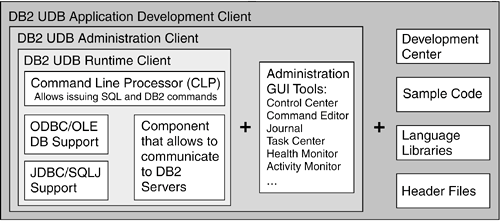Section 1.4. DB2 UDB Clients
1.4. DB2 UDB ClientsTo connect from a client machine to a DB2 UDB database server machine, you usually need to install DB2 UDB client software on the client machine. This isn't always required; for example, this isn't necessary for a JDBC application using the type 4 driver running on the client machine. We provide more detail about connectivity scenarios in Chapter 6, Configuring Client and Server Connectivity. A DB2 UDB client installed on a different machine than the DB2 UDB server is known as a remote client. A remote client can establish communication to the server using any of these supported communication protocols: TCP/IP, NetBIOS (Windows only), APPC (IBM environments only), and Named Pipes (Windows only). If the DB2 UDB client is installed on the same machine as a DB2 UDB server, then it is known as a local client and it connects to the server using inter-process communication (IPC) on the same machine. Note that since all DB2 UDB servers come with a local client component, you don't need to install the DB2 UDB client separately after installing a DB2 UDB server. Figure 1.7 shows local and remote clients. Client Machine 1 and 2 are remote clients with the DB2 UDB client code installed and are accessing Server Machine A, which has a DB2 UDB server installed. The DB2 UDB server has a client component that is the local client. Figure 1.7. Local and remote DB2 UDB clients There are four types of DB2 UDB clients:
A thin client, also known as a dumb terminal, is a machine with no operating system or DB2 client code. All libraries and modules required to fulfill a request are loaded from a server having this code, including the DB2 client code. Figure 1.8 shows an example of thin clients. The DB2 client box represents the runtime, administration, or application development client. Figure 1.8. A thin client
Each DB2 client, other than the thin client, is built on top of the other types of clients. A runtime client has the minimum basic requirements to connect to DB2 servers and to provide basic client functionality. The administration client comes with everything the runtime client has, plus graphical administration tools. The application development client includes all of the functionality of the administration client, plus development tools and libraries. Figure 1.9 illustrates this client progression. Figure 1.9. The DB2 Clients |
EAN: 2147483647
Pages: 313
